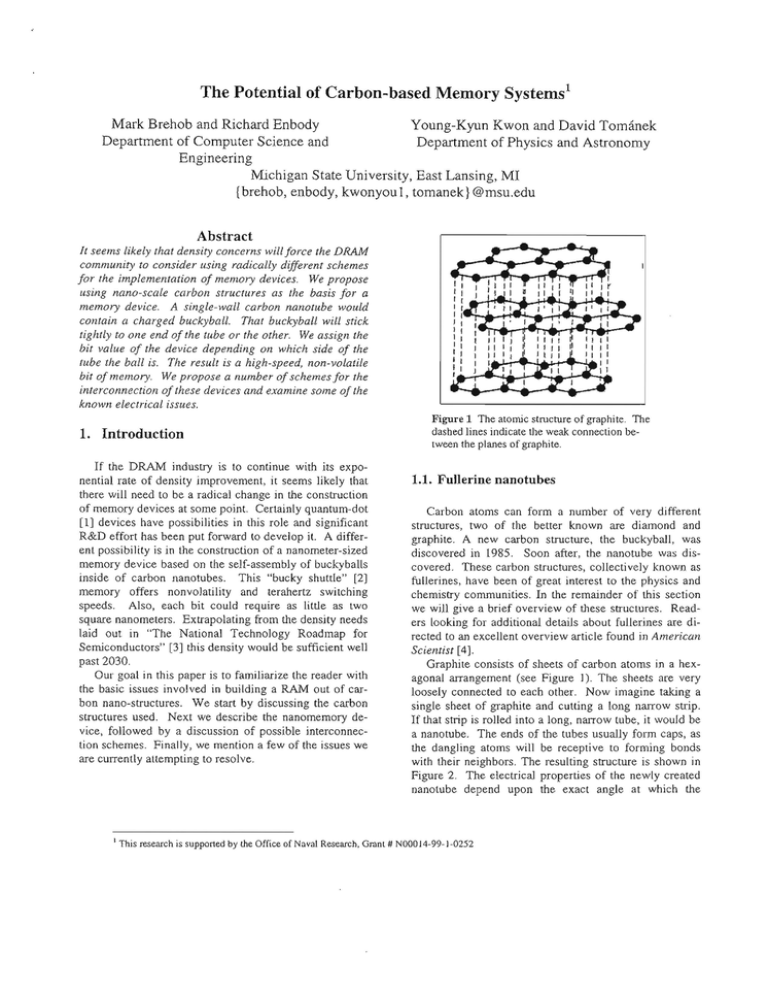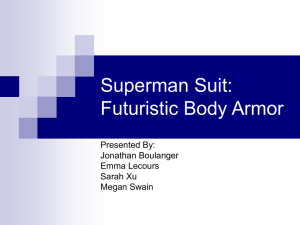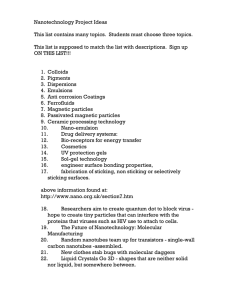The Potential of Carbon-based Memory Systems
advertisement

The Potential of Carbon-based Memory Systems l
Mark Brehob and Richard Enbody
Young-Kyun Kwon and David Tomanek
Department of Computer Science and
Department of Physics and Astronomy
Engineering
Michigan State University, East Lansing, MI
{brehob, enbody, kwonyou 1, tomanek} @msu.edu
Abstract
It seems likely that density concerns will force the DRAM
community to consider using radically different schemes
for Ihe implementation of memory devices. We propose
using nano-scale carbon structures as the basis for a
memory device. A single-wall carbon nanotube would
contain a charged buckyball. That buckyball wiLL stick
tightly to one end of the tube or the other. We assign the
bit value of the device depending on which side of the
tube the ball is. The result is a high-speed, non-volatile
bit of memory. We propose a number of schemes for the
interconnection of these devices and examine some of the
known electrical issues.
1. Introduction
If the DRAM industry is to continue with its exponential rate of density improvement, it seems likely that
there will need to be a radical change in the construelion
of memory devices at some point. Certainly quantum-dot
[1] devices have possibilities in this role and significant
R&D effort has been put forward to develop it. A different possibility is in the construction of a nanometer-sized
memory device based on the self-assembly of buckyballs
inside of carbon nanotubes. This "bucky shuttle" [2]
memory offers nonvoJatility and terahertz switching
speeds. Also, each bit could require as little as two
square nanometers, Extrapolating from the density needs
laid out in "The National Technology Roadmap for
Semiconductors" [3] this density would be sufficient well
past 2030.
Our goal in this paper is to familiarize the reader with
the basic issues involved in building a RAM out of carbon nano-structures. We start by discussing the carbon
structures used. Next we describe the nanomemory device, followed by a discussion of possible interconnection schemes. Finally, we mention a few of the issues we
are currently attempting to resolve.
I
Figure 1 The atomic structure of graphite. The
dashed lines indicate the weak connection between the planes of graphite.
1.1. Fullerine nanotubes
Carbon atoms can form a number of very different
structures, two of the better known are diamond and
graphite. A new carbon structure, the buckyball, was
discovered in 1985. Soon after, the nanotube was discovered. These carbon structures, collectively known as
fullerines, have been of great interest to the physics and
chemistry communities. In the remainder of this section
we will give a brief overview of these structures. Readers looking for additional details about fullerines are directed to an excellent overview article found in American
Scientist [4).
Graphite consists of sheets of carbon atoms in a hexagonal arrangement (see Figure I). The sheets are very
loosely connected to each other. Now imagine taking a
single sheet of graphite and cutling a long narrow strip.
If that strip is rolled into a long, narrow tube, it would be
a nanotube. The ends of the tubes usually form caps, as
the dangling atoms will be receptive to forming bonds
with their neighbors. The resulting structure is shown in
Figure 2. The electrical properties of the newly created
nanotube depend upon the exact angle at which the
This research is supported by the Office of Naval Research, Grant # NOaa 14-99-1-0252
Figure 2 A carbon nanotube
graphite was cut. A cut along one of the edges of the
hexagons would result in a conductive "armchair" nanotube. Other angles would result in semi-conductors and
even insulators. This chiral angle can range from 0° and
30°.
A buckyball can be thought of as the smallest of the
nanotubes. It is simply the connection of the two caps
with no "tube" in between, and consists of exactly 60
carbon atoms (see Figure 3). Its combination of hexagons and pentagons is exactly the same as that found on a
soccer ball. For historical reasons very short nanotubes
with 70, or even 80 atoms are sometimes also called
buckyballs. In this paper we will use the tenn only to
descri be
C60 .
;-~-------::----------,
....
-
Figure 3 A buckyball
2. The Nanomemory Device
Our proposed nanomemory device (NMD) consists of
two parts: the "capsule" which holds the much smaller,
charged "shuttle." In Figure 4 we show an example
where the capsule is a C240 nanotube while the shuttle is a
buckyball. The buckyball contains a potassium ion (K+)
which gives the shuttle its charge. (The potassium ion is
not shown in the figure.) The outer dimensions of this
capsule would be about lAnm in diameter and about
2.0nm in length. This K+ inside of a C 60 inside of a C 240
(K+@C60 @C 240) structure is the smallest and simplest
device we 11ave considered. However we are also examining other options such as longer capsules which use
other nanotubes as shuttles, as well as having many
charged shuttles inside of each NMD.
The state of the memory device is determined by the
location of the shuttle: if it is on one side of the cnpsule,
we treat it as a '['; on the other we treat it as a '0'. The
Van der Waals forces between the tube and the shuttle
will tightly bind the shuttle to one end of the tube or the
other. There is an unstable equilibrium point when the
shuttle is in the exact middle of the capsule, but our proposed scheme for writing to the device would prevent the
shuttle from ever comin to rest there.
Figure 4 An example nanomemory device
2.1. Writing to the NMD
Figure 5 shows the potential energy of the shuttle at
various locations in the NMD. The solid line indicates
the potential energy curve when no electric field is applied. Notice that the two potential energy wells are
found when the shuttle is on one side of the capsule or
the other. These wells keep the shuttle bound to either
side of the capsule.
The other two lines display the potential energy when
a two-volt potential difference is applied. When such a
voltage is applied there exists only one local minimum,
and the shuttle will move to that side of the tube. It is
with this two-volt potential difference that we can write
to the NMD. In general the amount of voltage which
needs to be applied depends upon the length of the capsule. A field of 0.1 volts/A is sufficient to move the
shuttle from one side of the tube to the other.
One important issue is how long it takes to perform a
write to the NMD. Because of a bouncing effect observable in Figure 6 we have to wait for the buckyball to
come to a stop. As the figure shows the time to settle
will be about 20 picoseconds.
2.2. Reading from the NMD
Writing to the nanomemory devices is the easy part;
reading from them is much more challenging. Somehow
the state of the device must be sensed. We have proposed a number of ways to perform a read. The first
requires three wires to be connected to the capsule: one
on each end, and one in the middle. The position of the
a .. -.-.-.-.-.-.-.-.-.-,-.-.-._._._.
>'
\(:
CQJ":
:
~CE).:;
'-'~--,-- .','
CQ)
'0".': ,i
:·:0
----
-s:4
;.
a...
:
(J)
~1
i'D'
.....
<D
C
W
"bit 1"
:
--'.
'"
..
O.'
,.-.'-~''''
."
-;.
.
.
I
:"
"bit 0':...·······
....... -.
-
4
iii
o
0
~
Position
2
·4
"bit 0"
,
,
~
g 0
, , ,,"bit 1"
-2
~
:
. ",'
x
c:
I
-8 ~-*-_-':---!:---!:----,-lo------,J,="------,,L----"
"
468
rAI
Figure 5 Potential energy of the shuttle at different locations in
the capsule. The solid line is when no electric field is applied.
The dashed lines are the potential energy when the two-volt
potential difference is applied. [2)
buckyball is detected by examining the resistance between the middle wire of the nanotube and the ends. A
lower resistance will be found on the end that has the
shuttle. This three-wire solution has a number of problems, not the least of which is that making a connection
to the middle of a nanotube seems difficult. However, a
long capsule and shuttle would perhaps make this solution viable.
A device without the middle wire would be easier to
fabricate. The notion of a destructive read could be applied here. A read would then be performed in the same
way as a write. During that write some current will flow
if the shuttle moves from one side of the nanotube to the
other. The total current that will t10w is limited by the
amount of charge held in the shuttles. It is for this type
of a read that we would use many shuttles in our capsule
to attempt to increase the amount of the current flow.
Neither of these reading schemes is particularly satisfactory. We are currently working on other read schemes
that appear to be more workable.
3. From NMD to RAM
Once the memory device is fabricated it will still be a
challenge to integrate the devices into a large RAM cell.
We currently foresee two possible implementations
which we call "metal-wired" and "nano-wired." We view
the metal-wired approach as the most viable implementation in the near term. However, it is equally useful as a
stepping stone on the path to the nano-wired device
which offers tremendous density improvements.
3.1. Metal-wired
The easiest device to fabricate would replace the traditional DRAM capacitor/transistor memory cell with a
large number of nanomemory devices. We believe cur-
o
2
4
6
8
10
12
14
16
Figure 6 Location vs. time of the shuttle as a write is preformed. Time is in picoseconds. [2]
rent VLSI fabrication techniques could be used, but with
the addition of a layer of nano-devices. A "forest" of
nanotubes has been already built [5], and a similar technique could be used to create a forest of memory devices
between two conducting layers. Figure 7a is a representation of a 4-bit nanomemory device. Figure 7b shows a
more detailed view of a single bit. Notice that a number
of nanomemory devices are used to make up a single bit
of memory. The number of devices per bit will depend
upon the minimum line siz.e of the lithography process
used. With a 70nm wire width there could be nearly
1,000 nanomemory devices per bit.
(a)
c
(b)
D
Figure 7 (a) 4-bit nanomemory device with wires A, B, C, and
D. (b) a single-bit using forest of NMDs.
Consider how a write to the memory device in Figure
7 would work. Assume that a voltage differential of 2.0
volts will move the shuttles from one side of the capsule
to the other. In order to write a '0' to bit three we would
have to apply a +1.0 volt potential to wire B while we
apply a -1.0 volt potential to wire D. If all the other
wires are held at ground, only at the addressed bit will
there be a strong enough electrical field to the shuttles.
We would write a '1' by reversing the voltages. Writing
to an entire row (or column) would be a two-stage process as the I 's and the O's would have to be written at different times.
Now, consider a destructive read with a forest of
nanotubes. Our forest of nanotubes would move a large
number of charged ions. We should be able to detect if
those ions moved or noL. Clearly we will have destroyed
the data in the process of doing the read. However, we
can write it back later, much as it is handled in a traditional DRAM.
This metal-wired carbon nanomemory device has a
number of useful features. It is non-volatile, the device
itself switches very quickly, and it would seem to be just
as buildable using 70nm lithography as it is using 350nm
lithography.
:£12
~
a
~
0-
8
f
~ 4
00
2
4
6
8
10
12
14
16
Time [ps)
Figure 8 The heat generated by the shuttle slamming
into the capsule during a write. [2J
3.2. Nano-wired
In this scheme, the memory array could be made entirely out of nanomemory devices and carbon nanowires.
The metal wires would be replaced by conducting nanotubes. Each bit of memory would now use only a single
NMD. The logic, sense-amps and pads would likely be
made using traditional devices. (However, it should be
noted that transistors can be built from nanotubes [4].) It
would otherwise be similar to the metal-wired proposal.
Nano-wires would allow for very high densities, with
each bit fitting in about two square nanometers. Laying
out this network of carbon would require self-assembly
techniques well beyond anything we can do today. We
believe that work in the area of carbon self-assembly is
progressing well enough that this solution may be viable
in 15 to 20 years.
4. Questions
Q: How much heat is generated by the coUision of the
shuttle into the capsule?
A: We aren't really sure yet. As shown in Figure 8,
simulations at 0° Kelvin show an increase in temperature of to to 12 degrees. At room temperatures
we expect a little more heat to be generated. However, nanotubes are excellent conductors of heat, and
we expect to be able to dissipate that heat quickly.
Q: Won't the nanotube act as a Faraday cage thus
preventing an electric field from entering the
nanotube?
A: Yes. This means that we need an electrical connection to the capsule. Such a connection would greatly
reduce or eliminate the screening effects.
Q: Just how conductive are nanotubes?
A: This is currently an issue under a great deal of study.
As noted above, the conductivity depends upon the
chiral angle of the nanotube. Measured resistivities of
nanotubes have ranged from greater than 5 Dcm to
less than 5.1xlO-6 Dcm [6]. However, resistivity may
be an irrelevant measure of a nanotube. Nanotubes
have been experimentally shown to be quantum conductors [7]. Further, there is some early evidence that
ballistic transport occurs along nanotubes.
This
would seem to indicate that resistance is independent
of the length of the nanotube. In all honesty this result
is a little difficult for those of us that are engineers to
accept, but we recognize that quantum physics can
lead to counter-intuitive results.
5. Conclusion
Our proposed nanomemory device is one candidate
for carrying memory devices beyond the limits of current
DRAM technology. It has three important characteristics: it is small, non-volatile, and fast. At this point the
carbon nanomemory has been simulated and buckyballs
inside of nanotubes have been created, but a working
memory device does not exist. Building it will be a challenge, but self-assembling carbon nanotechnology is an
active research area with continuous and promising advances. The feasibility of our device improves daily.
[1] K. Yano, "A 128Mb early prototype for gigascale singleelectron memories," in International Solid-Slate Circuits
Conference (ISSCC), 1998.
[2) Y-K. Kwon, D. Tomanek, and S. Iijima, '''Bucky shuttle'
memory device: synthetic approach and molecular dynamics simulations," Physical Review Letters, vol. 82, pp.
1470-1473,15 Feb 1999.
[3] Semiconductor Industry Association, National Technology Roadmap for Semiconductors: Technology Needs,
1997, http://notes.sematech.org/ntrslPublNTRS.nsf.
[4] B. I. Yakobson and Richard E. Smalley, "Fullerene nanotubes: CUIOO.OOO and Beyond," American Scientist, vol. 85,
pp. 324-337, July-August 1997.
[5} M. Kusunoki, J. Shibata, M. Rokkaku, and T. Hirayama,
"Aligned carbon nanotube film self-organized on a SiC
wafer," Japanese Journal ofApplied Physics Part 2 Letters, vol. 37, Issue 58, pp. L605-L606, 1998.
[6] T.W. Ebbensen, H.1. Lezec, H. Hiura, J.W. Bennett, H.F.
Ghamemi and T. Thio., "Electrical conductivity of individual carbon nanotubes," Nature, vol. 382, pp. 54-56,4
July 1996.
[7] S. Frank, P. Poncharal, Z.L. Wang, and W. A. de Heer,
"Carbon nanotube quantum resistors," Science, vol. 280,
pp. 1744-1746, 12 June 1998.





